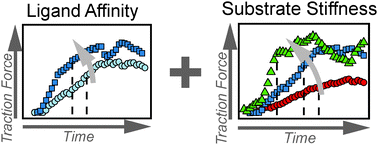Distinct impacts of substrate elasticity and ligand affinity on traction force evolution†
Abstract
Cell adhesion is regulated by the mechanical characteristics of the cell environment. The influences of different parameters of the adhesive substrates are convoluted in the cell response leading to questions on the underlying mechanisms, like biochemical signaling on the level of adhesion molecules, or viscoelastic properties of substrates and cell. By a time-resolved analysis of traction force generation during early cell adhesion, we wanted to elucidate the contributions of substrate mechanics to the adhesion process, in particular the impact of substrate elasticity and the molecular friction of adhesion ligands on the substrate surface. Both parameters were independently adjusted by (i) an elastic polyacrylamide hydrogel of variable crosslinking degree and (ii) a thin polymer coating of the hydrogel surface controlling the affinity (and the correlated substrate–ligand friction) of the adhesion ligand fibronectin. Our analysis showed two sequential regimes of considerable force generation, whose occurrence was found to be independent of substrate properties. The first regime is characterized by spreading of the cell and a succeeding force increase. After spreading cells enter the second regime with saturated forces. Substrate elasticity and viscosity, namely hydrogel elasticity and ligand affinity, were both found to affect the kinetics and absolute levels of traction force quantities. A faster increase and a higher saturation level of traction forces were observed for a higher substrate stiffness and a higher ligand affinity. The results complement recent modeling approaches on the evolution of forces in cell spreading and contribute to a better understanding of the dynamics of cell adhesion on viscoelastic substrates.


 Please wait while we load your content...
Please wait while we load your content...